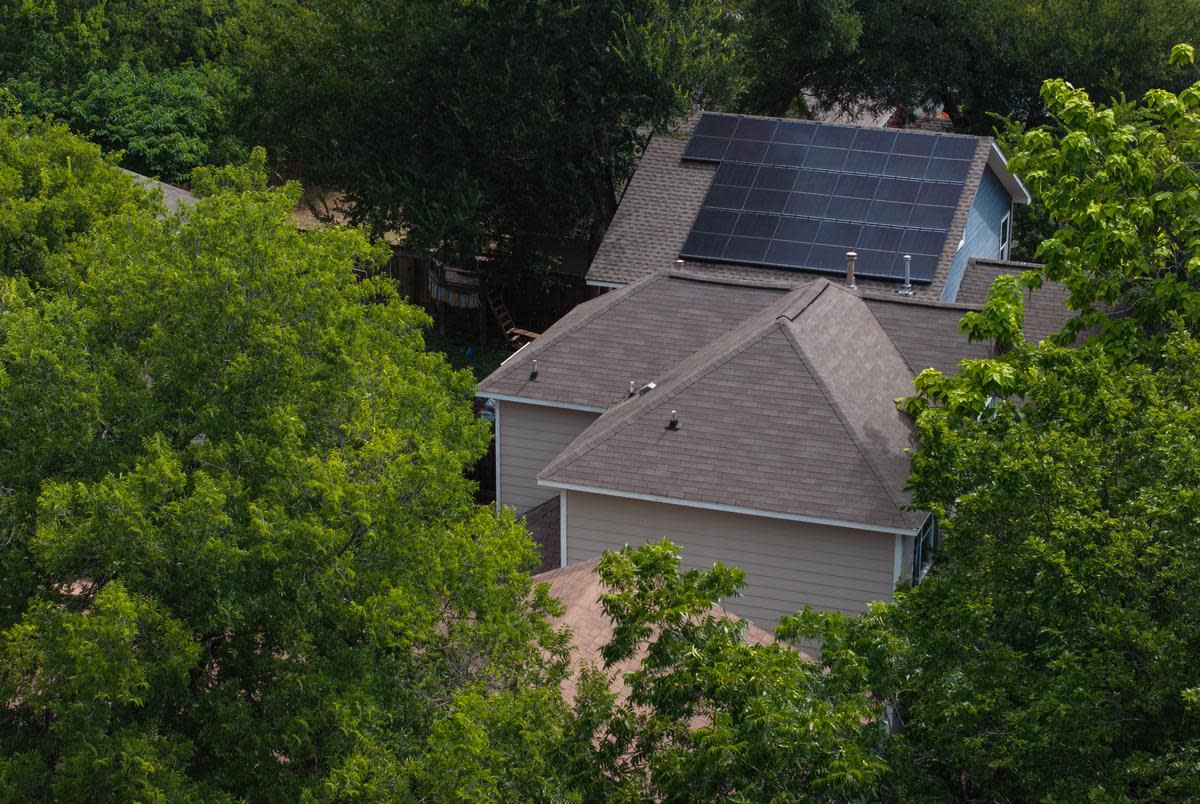Residential solar is growing in Texas amid worries about reliable power during events like Hurricane Beryl

This story is published in partnership with Inside Climate News, a nonprofit, independent news organization that covers climate, energy and the environment. Sign up for the ICN newsletter here.
While much of the Houston area suffered through heat and electricity failures following Hurricane Beryl last week, Bill Swann never lost power.
He could depend on the 16 solar panels mounted in his backyard and a battery system to provide for the basic needs of his house in the suburban community of Hilshire Village.
Asked if his neighbors are envious, he said he doesn’t know. Most of them have left their homes until the utility, CenterPoint Energy, is able to restore electricity.
“I love to brag about the fact that I’m living off of solar,” he said.
Solar aficionados in the area may know Swann as someone who runs free workshops about rooftop solar. He is a retired mechanical engineer, and one of his hobbies is designing and building solar systems, including his own.
He was one of the people I reached out to this week to get a sense of whether Beryl, along with longer-term concerns about the reliability of the grid, have made Texans more receptive to rooftop solar.
Such customer-owned resources are an essential part of the shift away from fossil fuels, helping to reduce demand on a grid that relies on natural gas power plants to produce electricity.
Texas ranks third in the country in electricity generation from small-scale solar, including rooftop solar, trailing California and Arizona, according to the Energy Information Administration. (The federal office defines small-scale solar as systems with capacity of less than 1 megawatt.)
On a per-capita basis, however, Texas ranks 20th, which indicates that there is a lot of room to grow. How much room is difficult to say, but a good way to frame it is that the state’s generation from small-scale solar last year was equivalent to about 1% of the total from large power plants.
The state has the technical potential to cover more than 30% of its electricity consumption with rooftop solar, according to a 2018 paper from the National Renewable Energy Laboratory. I’m cautious in citing this figure because the underlying data is more than a decade old, and because technical potential is usually a lot more than markets or consumer preferences will bear. An official at the lab tells me researchers there are working on an update to this research, which may be available next year.
In recent years, Texas has increased its electricity generation from small-scale solar at a rapid pace. In 2023, the state generated 4,337 gigawatt-hours from this category, an increase of 45% from the prior year, according to EIA. Of the 10 states with the most generation from small-scale solar last year, only Florida had more percentage growth, with 47%.
“I think the public is ready to embrace a paradigm shift in how we manage power distribution in Houston,” said Rafael Lemaitre, spokesperson for Power Up Harris County, a coalition of labor and community groups that want to expand the use of rooftop solar and other distributed energy technologies in greater Houston.
“I don’t think most people know what distributed energy distribution is,” he said. “But what they do know is the current status quo isn’t working, and they’re thirsty and eager for change.”
Houston is among the cities getting a substantial boost in funding for rooftop solar and community solar from the Biden administration’s Solar for All program, which is providing about $250 million to a Harris County-based group of nonprofits. The beneficiaries will mainly be low- and moderate-income households.
Texas has done little to encourage development of rooftop solar through state or local tax breaks or policies, but residents can receive federal benefits such as the investment tax credit, which is worth 30% of the cost of a system.
Some of the main drivers of rooftop solar in Texas have been a desire to reduce exposure to rising utility costs and concerns about reliability of the grid, said Ryan Barnett, senior vice president of policy and market development for Palmetto, a North Carolina-based climate tech company whose products include solar and battery storage.
“Texas is a fast-emerging behemoth of a distributed energy resource market,” he said.
His company saw a big increase in interest from Texas customers following the 2021 winter storm that led to power outages. Palmetto is active in more than 20 states.
“As reliability suffers, and consumers lose power more often or for longer periods, their interest in technologies and equipment that can provide them with better resiliency surges,” he said.
Beryl is likely going to increase the momentum that already was building in Texas, he said.
Another key variable is that the costs of solar and storage have mostly been flat while utility costs continue to rise. A solar system may cost about $20,000, but the savings on electricity bills will cover the costs in less than seven years, according to EnergySage.
The discussion of costs is part of the argument that Bill Swann has been making to anyone who will listen for more than a decade. He said it’s much easier to convince people these days.
“There’s a strong economic case for solar,” he said. “The payoff is usually about 8, 10, 12 years … And then after that, it’s free energy.”
Disclosure: CenterPoint Energy has been a financial supporter of The Texas Tribune, a nonprofit, nonpartisan news organization that is funded in part by donations from members, foundations and corporate sponsors. Financial supporters play no role in the Tribune's journalism. Find a complete list of them here.
Big news: director and screenwriter Richard Linklater; NPR President and CEO Katherine Maher; U.S. Rep. Pete Aguilar, D-California; and Luci Baines Johnson will take the stage at The Texas Tribune Festival, Sept. 5–7 in downtown Austin. Buy tickets today!

